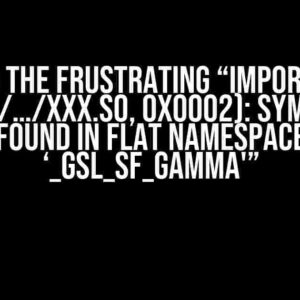Are you tired of manually searching for active snippets for a specific language in your extension? Do you want to automate the process and make your life as a developer easier? Look no further! In this comprehensive guide, we’ll show you how to get all active snippets for a given language programmatically in an extension.
What are Active Snippets?
Before we dive into the nitty-gritty of getting active snippets programmatically, let’s take a step back and understand what they are. Active snippets are reusable code blocks that can be inserted into your code with just a few keystrokes. They’re like code templates, but much more powerful and flexible. With active snippets, you can automate repetitive tasks, reduce coding time, and increase your overall productivity.
Why Get Active Snippets Programmatically?
So, why bother getting active snippets programmatically? Here are just a few compelling reasons:
- Efficiency**: By automating the process of finding active snippets, you can save time and focus on more important tasks.
- Consistency**: Programmatically retrieving active snippets ensures consistency in your code, reducing errors and inconsistencies.
- Scalability**: As your codebase grows, manually searching for active snippets becomes impractical. Getting them programmatically scales with your project.
The Anatomy of a Snippet
Before we dive into the code, let’s break down the anatomy of a snippet:
| Property | Description |
|---|---|
| Language | The programming language the snippet is written in (e.g., JavaScript, Python, etc.) |
| Prefix | A unique identifier for the snippet (e.g., “console.log”) |
| Body | The actual code snippet (e.g., “console.log(‘$1’);”) |
| Description | A brief description of what the snippet does (e.g., “Logs a message to the console”) |
Getting Active Snippets Programmatically
Now, let’s get to the good stuff! To get all active snippets for a given language programmatically, you’ll need to use the following tools:
- VSCode API**: The VSCode API provides a set of methods and interfaces for interacting with the editor.
- Snippets API**: The Snippets API is a part of the VSCode API that specifically deals with snippets.
- TypeScript**: We’ll use TypeScript to write our code, but you can use JavaScript if you prefer.
Step 1: Set up Your Environment
Before we start coding, make sure you have the following set up:
- A VSCode extension project (you can use the
yo code-extensiongenerator to create one) - TypeScript installed globally (
npm install -g typescript) - The VSCode API and Snippets API types installed (
npm install @types/vscode @types/vscode-snippets)
Step 2: Create a Snippet Provider
Create a new file called snippetProvider.ts and add the following code:
import { Snippet, SnippetProvider } from 'vscode-snippets';
export class MySnippetProvider implements SnippetProvider {
async provideSnippets(language: string): Promise<Snippet[]> {
// We'll implement this method in the next step
}
}
Step 3: Implement the Snippet Provider Method
In the provideSnippets method, we’ll use the VSCode API to get all active snippets for the given language:
import { Snippet, SnippetProvider } from 'vscode-snippets';
import { workspace } from 'vscode';
export class MySnippetProvider implements SnippetProvider {
async provideSnippets(language: string): Promise<Snippet[]> {
const snippets: Snippet[] = [];
const snippetFiles = await workspace.findFiles(`**/*.${language}`, '**/node_modules/**');
for (const snippetFile of snippetFiles) {
const snippetContent = await workspace.readFile(snippetFile);
const snippetJSON = JSON.parse(snippetContent.toString());
snippets.push(...snippetJSON.snippets);
}
return snippets;
}
}
In this code, we:
- Use the
workspace.findFilesmethod to search for snippet files with the given language extension (e.g.,**/*.jsfor JavaScript) - Read the contents of each snippet file and parse the JSON data
- Extract the snippets from the JSON data and add them to our array
- Return the array of snippets
Step 4: Register the Snippet Provider
Finally, register your snippet provider in your extension’s activate method:
import { extensions } from 'vscode';
import { MySnippetProvider } from './snippetProvider';
export function activate(context: vscode.ExtensionContext) {
const snippetProvider = new MySnippetProvider();
context.subscriptions.push(extensions.registerSnippetProvider(['javascript'], snippetProvider));
}
In this code, we:
- Create an instance of our
MySnippetProviderclass - Register the snippet provider with the VSCode API, specifying the language(s) it supports (in this case, JavaScript)
That’s it! You should now have a working snippet provider that retrieves all active snippets for the given language programmatically.
Conclusion
In this comprehensive guide, we’ve shown you how to get all active snippets for a given language programmatically in an extension. By following these steps, you can automate the process of finding active snippets, reduce coding time, and increase your overall productivity.
Remember to experiment with different languages and snippet providers to unlock the full potential of active snippets in your extension.
Happy coding!
Frequently Asked Question
Get ready to dive into the world of coding and uncover the secrets of getting all active snippets for a given language programmatically in an extension!
What is the purpose of getting all active snippets for a given language in an extension?
Getting all active snippets for a given language in an extension allows developers to access and utilize pre-written code fragments, increasing coding efficiency and productivity. This feature is particularly useful for code completion, code refactoring, and code analysis tasks.
How do I retrieve active snippets programmatically in a VS Code extension?
You can use the `vscode.extensions.all` API to retrieve all active snippets for a given language. Specifically, you’ll want to use the `getExtension` method to access the snippets provider for the desired language, and then call the `getSnippets` method to retrieve an array of active snippets.
Can I filter snippets by language or scope?
Yes, you can filter snippets by language or scope using the `getSnippets` method. This method accepts an optional `languageId` parameter to filter snippets by language, and an optional `scope` parameter to filter snippets by scope (e.g., global, workspace, or file).
How do I handle snippet contributions from multiple providers?
When retrieving active snippets, you may encounter contributions from multiple providers. To handle this, you can use the `getExtension` method to access each provider’s snippets and then merge the results. Alternatively, you can use the `vscode.extensions.all` API to retrieve all snippet providers and iterate over them to collect the active snippets.
What are some best practices for handling snippet data in an extension?
When working with snippet data in an extension, it’s essential to follow best practices such as caching snippet data to improve performance, handling errors and exceptions gracefully, and ensuring snippet data is properly serialized and deserialized to maintain data integrity.




